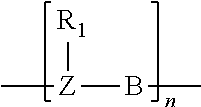Method of controlling organic contaminants in pulp and paper making processes
a technology of organic contaminants applied in papermaking, non-fibrous pulp addition, coatings, etc., can solve the problems of reducing paper machine efficiency and paper quality, serious problems for paper quality and pulp and papermaking efficiency, and reducing paper quality. , to achieve the effect of improving paper quality and improving down stream performance of papermaking equipmen
- Summary
- Abstract
- Description
- Claims
- Application Information
AI Technical Summary
Benefits of technology
Problems solved by technology
Method used
Image
Examples
example 1
Deposition Test of Sulfite Pulp and Deinked Pulp Mixture from Mill A
[0053]The standard mixing test procedure is used to evaluate the impact of chemicals on deposition tendency on mixing bowls and paddles. A KitchenAid® stand mixer with coated flat paddles, such as the Commercial 5 series from KitchenAid®, was used. The stainless steel mixing bowls were used to hold fiber stocks at consistencies from about 3% to about 20%, preferably from about 8% to 10%. The mixing temperature was controlled with a water jacket at 55° C. The pulp stocks were mixed at speeds between “1” and “4”, preferably “2”. The stocks were mixed for a period of time ranging from about 5 minutes to about 2 hours, preferably from about 20 minutes to about 1.5 hours.
[0054]Representative stock samples consisted of sulfite pulp stock with a consistency of about 12%. 100 g of oven-dried (OD) fiber was used for each test. Hot water (˜55° C.) was used to obtain a pulp consistency of about 11% and a desired amount of each...
example 2
Deposition Test of Sulfite Pulp from Mill a at Different pH Conditions
[0057]The standard mixing test procedure was used in this example. The pH was adjusted using 1 M HCl or 1 M NaOH before the chemical addition. The dosage for all the chemicals was 1.20 lbs / ton. The results are shown in Table 3. The control showed deposit on both paddles from pH4.0 to 8.5. The mixing bowl also showed deposits at about pH 7.9. For Cevol 540, the paddle deposit ranged from 35-80% at all pH values tested, and bowl deposits were around 25% at pH 7.71 and pH 8.57. However, in the presence of EDT-X2 at 1.20 lbs / ton, the paddle deposits were significantly reduced and ranged from 5 to 10% compared to the control paddle. Bowl deposits were completely eliminated at all pH values tested. This further confirmed that the use of aminoplast ether copolymers is more effective in reducing deposition of sulfite organic contaminants compared to polyvinyl alcohol.
[0058]
TABLE 3Standard Mixing Test Results at Different ...
example 3
Deposition Test of 100% Recycled Wastepaper from Tissue Mill B
[0059]Mill B uses coated book stock (CBS) and sorted office paper (SOP) wastepaper to produce tissue. Pulp from the washer accept having a consistency of about 12% was collected in the mill. Two pulp batch samples were collected at two different times. The standard mixing test procedure was used in this example with the water jacket temperature maintained at 55° C. and mixing times of 45 mins. 100 g oven dried fibers were used for each mixing test. The amount of stickies deposits on the paddles and mixing bowls for the control were rated visually as 100%, and other testing paddles and bowls were rated comparatively.
[0060]
TABLE 4Standard Mixing Test Result for CBS / SOP StocksTestRelative PaddleRelative BowlNumberConditionsDosageDeposition %Deposition %1ControlNo Chemicals10002Celvol 5400.80# / ton9503EDT-X20.80# / ton2004EDT-X30.80# / ton3005EDT-X10.80# / ton7506ControlNo Chemical10007Cevol 5401.0# / ton4508EDT-X21.0# / ton209EDT-X11.0...
PUM
| Property | Measurement | Unit |
|---|---|---|
| molar ratio | aaaaa | aaaaa |
| time | aaaaa | aaaaa |
| time | aaaaa | aaaaa |
Abstract
Description
Claims
Application Information
 Login to View More
Login to View More - R&D
- Intellectual Property
- Life Sciences
- Materials
- Tech Scout
- Unparalleled Data Quality
- Higher Quality Content
- 60% Fewer Hallucinations
Browse by: Latest US Patents, China's latest patents, Technical Efficacy Thesaurus, Application Domain, Technology Topic, Popular Technical Reports.
© 2025 PatSnap. All rights reserved.Legal|Privacy policy|Modern Slavery Act Transparency Statement|Sitemap|About US| Contact US: help@patsnap.com



